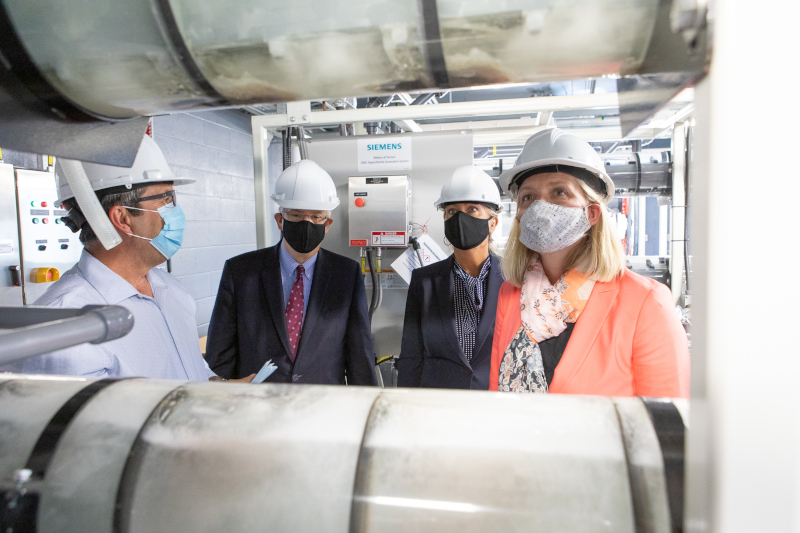Message from the Government of Canada
Building Back Stronger Post-COVID-19
Submission by: Minister Catherine McKenna, Minister of Infrastructure and Communities
COVID-19 is having a profound impact on our citizens, our countries, and on the world. The Government of Canada continues to take strong, decisive action to protect the health and well-being of Canadians, while ensuring people can put food on their table and keep a roof over their heads.
Critical, time-sensitive measures have been our immediate focus in this crisis – paying people’s wages, supporting the most vulnerable, and keeping businesses and industries afloat. Our government continues to respond to the most pressing public health concerns, while looking ahead. That is why Prime Minister Justin Trudeau announced the $19-billion Safe Restart Agreement in July, which includes billions of dollars for cities and towns across Canada to help cover municipal operating costs, protect the health of Canadians, get people safely back to work, and prepare for a second wave.

Minister, Catherine McKenna
As the Minister of Infrastructure and Communities, I have also been focusing on the long-term and how investments in infrastructure can play a vital role in addressing the needs of communities and reviving local economies. Our current situation highlights the importance of my top three priorities: to work with partners to get projects built quickly, to unleash the power of infrastructure to grow our economy and create jobs, and to consider the environment in everything we do. We want to build back better for the 21st century and beyond, starting with a strong response to COVID-19.
That means making our programs work better for Canadians. For example, at Infrastructure Canada we made changes to our Investing in Canada Infrastructure Program so that projects get approved faster, and in August I introduced a temporary new funding stream to support the COVID-19 response and economic recovery efforts. It’s all part of the Investing in Canada plan, through which the Government of Canada is investing more than $180 billion over 12 years to build a more prosperous, more resilient and more sustainable future for our children and grandchildren.
Our Plan supports projects in five streams that our partners have identified as keys to the success and sustainability of their communities: public transit; green infrastructure; social infrastructure; trade and transportation; and rural and northern communities’ infrastructure. And we have made the plan more flexible and responsive to our partners’ needs with the new COVID-19 Resilience funding stream, with over $3 billion under the bilateral agreements we have with each province and territory.
Canadians from coast to coast to coast are seeing the benefits of the Plan—our government has already committed over $65 billion and invested in thousands of projects. And the new COVID-19 Resilience stream will further benefit Canadians by investing in more pandemic-resilient infrastructure projects, such as retrofitting schools to allow kids to go to class safely, upgrading hospitals and long-term care homes to deal with social distancing requirements, or building new parks, cycling and walking paths.
Building a strong, sustainable and inclusive country
This health crisis is showing us where we have gaps in our infrastructure. We’re working closely with all orders of government and other partners and stakeholders across the country to keep a sharp focus on long-term objectives that will improve the quality of life in all our communities—from better public transit to affordable housing and clean water.
One critical gap this pandemic has highlighted is the need for access to high-speed Internet – it is one of the main lifelines during this current health crisis to live, study, work, and compete in today’s digital world. We see new examples every day of why reliable Internet and mobile connectivity are essential and will be critical to our economic recovery post-COVID-19. In the 2019 federal budget, the federal government announced $1.7 billion to support high-speed Internet, including $1 billion for the new Universal Broadband Fund (UBF). The UBF is part of a suite of initiatives to ensure high-speed Internet access for all Canadians, especially those in rural and remote locations.
Around the world we are seeing how “smart” approaches and connected technologies are helping communities respond to COVID-19 and plan for a recovery that rebuilds communities so they are more resilient than before. The Canadian Smart Cities Challenge encourages communities to identify innovative ways to improve the lives of their residents through data and connected technology, starting with community-based engagement on pressing local needs. The first round received an incredible number of submissions. Winners and finalists alike are bringing their proposals to life to tackle issues such as mental health, energy, poverty, public transit, and the sharing of traditional culture and knowledge.
One inspiring example that has evolved during the pandemic is in Ontario. There, one Smart Cities Challenge winner is adapting its project to the realities of COVID-19. The City of Guelph and the County of Wellington are working to transform their regional food ecosystem. They are leveraging big data and technology to become Canada’s first Circular Food Economy, which aims to increase access to nutritious food and find ways to repurpose food that is thrown out. Their winning proposal also includes a rural broadband access pilot program, work on the county’s solid waste management master plan, and other initiatives. When the pandemic hit, the city amended its project to include an emergency food relief plan to provide those in need with access to nutritious food, as part of their “Grow Back Better: Our Food Future’s 10-point COVID Recovery Plan.”
Programs such as the Smart Cities Challenge aim to support big ideas that solve community problems. At the same time, communities across the country are facing new and different challenges during the current health crisis. The top-of-mind issue today is how we safely reopen during an ongoing pandemic. That is why we have created the Canada Healthy Communities Initiative. I announced the new program in August.
The goal of the Healthy Communities Initiative is to make our cities and towns more livable, more active, healthier and more accessible. This new program will repurpose approximately $31.3 million from the Smart Cities Challenge to help fund smaller, local projects that can be completed quickly. Whether it’s creating safe and vibrant public spaces, helping people get around more easily, or improving digital access such as Wi-Fi hotspots, these locally-driven solutions will help communities safely re-engage and re-energize. By inspiring communities to come together, form partnerships and explore ways to address these challenges, we’re creating the foundation to tackle bigger issues that are defining our generation such as climate change.

Smart economic decisions = smart climate change decisions
We all benefit when infrastructure is improved. New walking and cycling paths allow us to stay active. New and upgraded waste water treatment plants and water mains keep our water clean. Broadband connects us digitally. Social housing provides a foundation for everyone in our communities to fully participate in society. We can all see and feel these changes. But what may not be as obvious is how vital infrastructure is to fighting climate change. We know that green infrastructure creates resilient communities and stronger economies. As well, the decisions we make about infrastructure now will not only help strengthen our economic recovery efforts but will also help put us on a path to meet our climate targets.
The Government of Canada is firmly committed to protecting the environment and achieving net-zero emissions by 2050, which is why the Investing in Canada plan is providing $26.9 billion to ensure access to safe water, clean air and greener communities where Canadians can watch their children play and grow. Of that, $9.2 billion is being invested through the Investing in Canada Infrastructure Program’s Green Infrastructure Stream in projects to reduce greenhouse gas emissions, help communities become more resilient to the effects of climate change, and to deliver clean water and safely manage wastewater. Infrastructure Canada has mandated that 45 per cent of this funding must go to reducing greenhouse gas emissions.
To help infrastructure owners plan their projects so they can withstand the effects of climate change and reduce carbon pollution and greenhouse gases, Infrastructure Canada implemented a Climate Lens assessment that is consistent with the objectives of the Pan-Canadian Framework on Clean Growth and Climate Change. We’re re-thinking our approach to infrastructure planning, from finding ways to reduce emissions and move closer to a net-zero carbon economy to building more resilient infrastructure that will help protect communities and industries from the impacts of climate change.
These critical innovations won’t happen with public resources alone, so we’re engaging the private sector, which also recognizes the investment and partnership potential of green infrastructure. We established the Canada Infrastructure Bank (CIB) to help bridge the gap between public and private funding, and it will play a critical role in Canada’s recovery from this pandemic. The Bank is actively working to attract private investments to help advance public policy objectives on complex, long-term challenges, and to help public dollars go further. Right now, the CIB is working alongside federal, provincial and territorial partners to build a portfolio of public and private partnerships in clean electricity that, when taken together, offer the potential to make a substantial contribution to supporting Canada’s greenhouse gas reduction goals.
In my job as the Minister of Infrastructure and Communities, the importance of strong communities has never been so clear. If anything good has come of this pandemic, it is a heightened awareness of what it means to be part of a community. We’ve seen how crucial it is to look out for each other, to protect each other and to see every day that our community is what we choose to make of it. I find myself constantly thinking about how infrastructure investments support and strengthen communities across Canada.
It also means helping attract new investments from everywhere. Businesses want to locate and build where they know infrastructure is modern, clean, and resilient. Canada has an excellent opportunity to be the low-carbon economy that global investors beat a path to if we keep making smart choices right now. Putting tax dollars to work – in clean water, in better transportation, more efficient buildings, renewable energy, flood and fire protection, better broadband – helps provide good jobs, stabilizes the economy, and helps communities get back on their feet.
And those investments do so much more. They help build a better country for our children and grandchildren.

